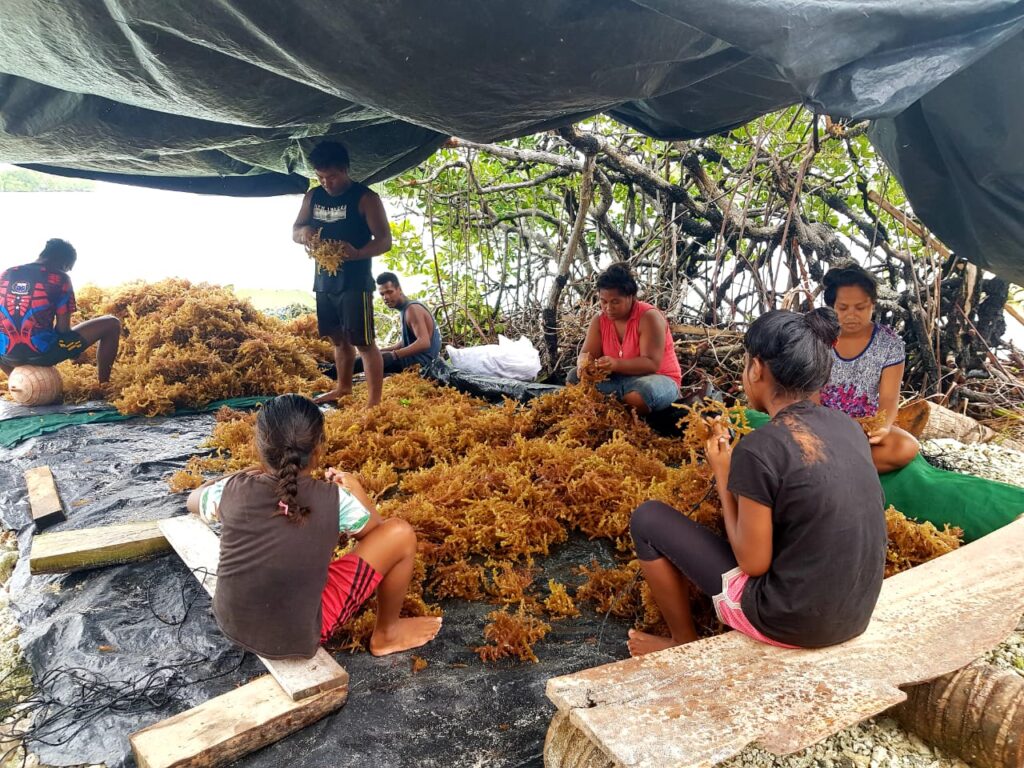BY JEREMY GWAO
Teue Sito, a 30 year old seaweed farmer from Wagina Island in Solomon Islands, works over 12 hours everyday in her family’s farm, ensuring that their seaweeds are safe until they can be sold. But lately their product has not been the same.
“I planted my seaweed in January this year and I harvested it in March this year and nothing seems to change about the size of the seaweed plant. I have to harvest it, because it has already passed the harvesting period,” Teue added.
Sea level rise in the Solomon Islands is affecting seaweed farms, which is an important agricultural activity in the country. The marine plants have been reducing in size in the last few years, according to the farmers.
Seaweed is a product that depends on a suitable environment to grow. Climate change has slowed growth of the plants, which affects the whole production process.
Wagina Island is well-known for the seaweed farming after it was introduced in 2002. Now, the activity sustains around 600 farmers and accounts for 3% of the country’s GDP, a production that is mostly exported to China at about $4 USD per kilogram.
The farmers grew the seaweed near the coastline of Wagina Island for decades, using a clear understanding of the tides. However, in the last few years, tides haven’t behaved normally, forcing them to adapt at a fast pace, farmers said.
Seaweeds is an aquatic plant amongst the 50 other seagrasses called Kappaphycus. This marine plant has one of the highest demands for exports to places like Europe, Indonesia and China.
In the Solomon Islands, Wagina Island became one of the focal points for kelp farming. The island served to relocate about a thousand Gilbertese Solomon Islanders between 1952 and 1957.
These migrations arised from a relocation’s agreement called Gilbertese Relocation Scheme, which settled migrants fleeing famine from Kiribati to Solomon Islands. This population currently lacks proper access to services like health, education and security.
At a global level, seaweed farming is regarded as a potential climate solution, because of its capacity to capture CO2 from the atmosphere. Coastal ecosystems can sequester up to 50 times more carbon than forests, according to the scientific organization Conservation International.
However, sea level rise and ocean acidification are threatening kelp forests from all over the world. In Tasmania, for example, these climate impacts erased about 95% of seaweed forests in the past 80 years.
Farming against climate
Sito has worked on her father’s farm since she was six years old. “I have seen that only through our seaweed farming our family got to survive till today,” Teue said.
Seaweed farming is not an easy task: it requires a lot of time and effort, says the local farmer. Before selling the kelp, farmers need to plant it, give it maintenance, harvest it, dry it and just then they can sell it, she said.
To produce the kelp, farmers tie healthy pieces of the plant on a 3 or 4 mm rope and leave it under water to mature. In about 6 weeks, depending on the local environment condition, they harvest it.
The kelp needs particular conditions to grow properly. Water temperature, for example, should range between 25 and 30°C, while the planting sites must be shallow (just 1 meter deep) and with a hard seabed.
But sea level rise —accentuated by climate change— is changing these environmental conditions, Teue explained. For example, the depth and temperature of the water change as the sea levels rise.
Due to the changing conditions, seaweed farmers are starting to relocate from the eastern side of the island to the western end, True said. However, planting sites are scarce and demand is high, since about 95% of the local population depends on kelp, the farmer said.
“We have to move because of the strong currents. Our seaweed are washed by the current and so we have to find another planting ground,” Teue added.
Farmers not only saw these changes in Wagina, but also in Rarumana —around 8 km away in the Western Province—, where Wilfred Luiramo made similar observations about the growth of the seaweed in the last few years.
“Some of the changes I noticed are that due to climate change, the growth of seaweed is very slow, not like the past 10 years and also the weather pattern really affects the farmers,” Luiramo said.
Less quality
According to Luiramo, if impacts like these continue, the farmers risk a decrease in the seaweeds’ quality, forcing them to find other sources of income.
When farmers in Wagina Islands started planting seaweed back in the 1950s, the high tide normally rose to the same point. Workers could easily know where to plant the seaweed and they could spot planting grounds without problems, they said.
But the tides have been rising higher in the last few years, they explained. Because of this, the seaweed breaks from the ropes that the farmers use to tie it down, which leaves them with less product available.
The erratic tides also mess with their harvesting calendar, they say. For decades farmers have known the best times to harvest seaweed, usually following a three month period. Today, that same time might not give the same results anymore, they added.
As a result, their product is changing. For example, the normal colour of the seaweed (Kappaphycus) is green and brown, but as the sea started to change most farmers noticed that the colour of the plant had changed too, becoming more white.
The change in colour means the kelp has less quality, and is not suitable for exporting, the farmers explained.
Size was also part of those changes, as the plants started to grow less, resulting in a further diminishing of their quality. Under normal conditions, the plants should weigh 1 kg after three months of growth. But now, the seaweed barely reaches 500 grams in the same amount of time, the farmers said.
Luiramo, the farmer from Raruama, said “there is no option” but relocating when the sea levels start to rise in a planting site.
“The reason is the seaweeds are soft. If there is sea-level rise definitely they will break off from the ropes. So there is nothing that we can do but to keep monitoring 24/7,” he added.
“We need alternatives”
Farmers and environmental organizations have called for increased support to the seaweed workers, who are facing losses because of climate change. They claim government support has not been enough.
“Today we need another alternative sector that we can generate income for our families or else provide some help that we can adapt to keep us contusing our seaweed farming,” said Lupe Kiatioa, a seaweed farmer from Wagina..
The farmers have faced small losses compared to the ones yet to come, said David Boseto, Team leader of the conservation organization Ecological Solutions Solomon Islands (ESSI). The government plans, so far, have fallen short, he says.
Boseto said the government should support the seaweed farmers with strategic plans, which should aim to provide farmers with self-resilience and business training.
The Director of the Climate Change Division of the Ministry of Environment, Hudson Kauhiona said the issue is urgent, since impacts could become too big on the farmers. According to him, the government has been working on awareness campaigns for the sector.
“We work closely with the Ministry of Fisheries in addressing climate change issues facing inshore and offshore of the country in terms of assistance, and specially in helping out on projects and activities,” he said.
However, the government official was clear that there are no current relocation projects in place. “Government has no direct allocations specifically for the seaweed industry in the Solomon Islands. It can only be done depending on projects, reports from the sites and surveys,” he added.
In the meantime, agriculture workers have no option but to face the impacts, they say. “Right now we accept all the changes and its impacts because we do not have any other options. My family relies too much on this for survival,” Kiatioa said.
Wilfred Luiramo added that proper aquaculture farming with a focus on climate resilience and adaptation is very low. “This requires proper training for seaweed farmers under the Ministry of Fisheries and Secretariat of the Pacific Community (SPC) on how to be resilient, with climate adaptation programs that are related to aquaculture,” he said.
About the Article
This was first publish on Climatetracker.org, an international non-profit organization,aiming to support, train and incentivise better climate journalism globally.

